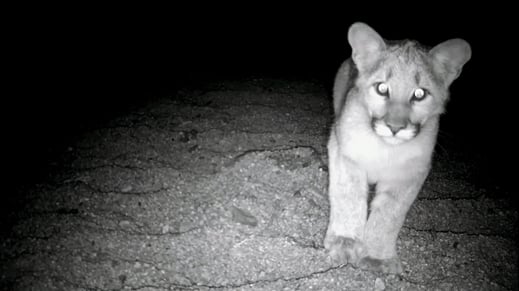Darkness had fallen in the Vail Valley. As I watched the last light fade on the summit of Bald Mountain, I heard crashing below my porch. Was it the massive black bear that had been frequenting the nearby forest? In the light of my cell phone, I saw four yellow-green eyes flashing up at me. Nope, not a bear, just two remarkably large raccoons.
It is always rather exciting to see eyes glowing at you in the dark. But what causes that eyeshine? And why don’t all animals’ eyes reflect?
Eyeshine is caused by a reflective layer in the back of the eye called the tapetum lucidum. Latin for “bright tapestry,” the tapetum lucidum is a layer of tissue behind the retina. This layer improves night vision by reflecting visible light back through photoreceptors in the retina, allowing light to stimulate light-sensitive cells a second time. This double dipping contributes to the superior night vision of some animals, including nocturnal creatures and those living under water. Diurnal animals, including humans and squirrels, lack a tapetum lucidum.
So, eyeshine is a visible effect of having a tapetum lucidum. And it’s a useful adaptation that allows animals to see at night or in low-light conditions, enhancing their visual sensitivity by as much as 50%. There must be at least some light available – not total darkness - for the tapetum lucidum to function.
 Mountain Lion Cub Captured by David Neils
Mountain Lion Cub Captured by David NeilsEyeshine comes in a variety of colors – blue, green, red, white, and yellow. Some sources say that you can identify an animal based on the color of its eyeshine. However, since eyeshine is a type of iridescence, color will vary with the angle at which you view it, the color of the light source, and the mineral content of the tapetum lucidum.
Generally, mountain lions and bears have eyeshine in the yellow-to-red range. Deer and elk eyeshine is white, but moose eyeshine tends to be red. Rabbits and pikas have red eyeshine. Blue eyeshine is seen in other mammals, including horses.
Foxes and domestic cats and dogs usually have green eyeshine, but cat eyeshine can also be orange to red.
Foxes and domestic cats and dogs usually have green eyeshine, but cat eyeshine can also be orange to red.
Eyeshine color can vary by breed, and even within breeds. Speaking of domestic cats, the difference in eyeshine color is caused by varying amounts of zinc or riboflavin in the tapetum lucidum. And blue-eyed cats, like Siamese, often lack a tapetum lucidum altogether.
When you detect a pair of eyes staring back at you in the night (hopefully, not in your car headlights), what factors besides eyeshine color are useful in identifying the owner of those eyes? Useful factors include:
- - Height of the eyes above the ground
- - Movement of the eyeshine – hopping, weaving, leaping, climbing, flying
- - Eye color, shape, and size
- - Pupil shape – predatory animals have vertically elongated pupils, while prey animals’ pupils tend to be horizontal.
For instance, at night, black bear have large, round, often yellow-to-orange (but sometimes red or green), nearly pupil-less eyes, set close to the ground. Wild feline eyes generally have a heavy upper eyelid, and a pupil that is perpendicular to the eye shape. White eyes a few feet above the ground probably belong to a deer or elk.
Our human eyes lack a tapetum lucidum, but under some conditions exhibit what looks like a reflection. For instance, the red-eye effect in photographs happens when a flash of light illuminates the blood-vessel-rich retina in the back of the eye. Another effect in humans and other animals that can resemble eyeshine is leukocoria, a white shine indicative of abnormalities such as cataracts.
As Halloween approaches, now you may know just a bit more about those eerie eyes staring at you through the night!
Frances Hartogh is a Volunteer Wilderness Ranger for ESWA, the Eagle Summit Wilderness Alliance.









